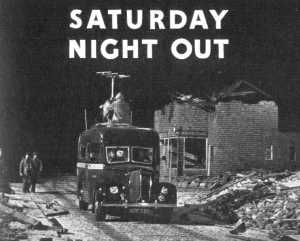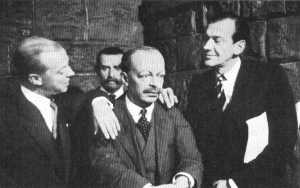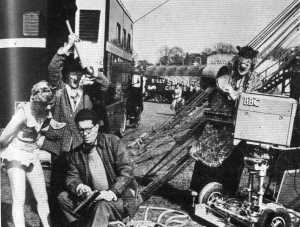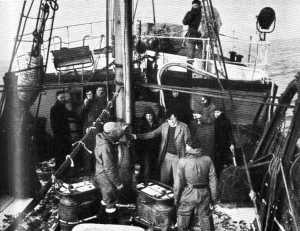
Home > Adults' Programmes > Saturday Night Out

"See things happen
When they happen
Where they happen"
Saturday Night Out was originally hosted by Robert Beatty as 'The Man with the Mike'. The memorable title sequence started with a picture of a telephone on a desk. This would ring and a voice would say: "Outside Broadcast, we're starting now...". The camera would then pan out of the window, where we saw the Outside Broadcast vans ("Roving Eyes") on the move and a BBC doorman saluting. The action would then cut to show the camera on the roof on the Roving Eye travelling fast down a straight road towards a hoarding showing the inscription "Saturday Night Out". The brakes would squeal and the camera would burst through the hoarding and cut to the O.B. live transmission for this week.
So began a weekly, hour long, live programme which was never filmed. The firm rule was that it was always live. One week it would be coming from the Midlands, the next week Brussels and the following week it might be Paris or London.
History was made when, on 16 June 1956, the first television pictures from inside a submarine whilst travelling below the surface were transmitted as part of Saturday Night Out. To enable this programme to be put on, the Royal Navy allowed the BBC to join in an exercise taking place in the English Channel between H.M. Submarine Tapir and the Anti-Submarine Frigate H. M.S. Grenville. Cameras were carried on both ships. Signals from the submarine were relayed by the frigate to a point on shore for onward transmission, and the programme was the climax of many tests carried out earlier in the year by the Royal Navy and all branches of Television Engineering, especially the Outside Broadcasts Experimental Team.
The programme would visit different locations each week. Subjects covered were, for example, a local fire station, Lowestoft fisherman at sea, a visit backstage to a Circus or a visit to a troopship moored at Harwich.
 |
 |

One Guy Fawkes Night programme covered a location in London where some enthusiasts had poured five gallons of petrol on to the bonfire to make certain of giving the viewers a good blaze. When it was lit, the flare-up was so violent that the heat set off most of the fireworks nearby and sent the children scampering over the fence!
The programme was produced by Derek Burrell-Davis who also co-edited with Peter Webber. Production Assistant was Bryan Cowgill.
An Outside Broadcast unit was attached to each BBC main and regional centre and consisted of a Mobile Control Room fully equipped for the operation of three cameras and the necessary microphones. Considerable use was made of zoom lenses in outside broadcasts. Each unit also included tender vehicles for transporting cameras, cables and ancillary equipment. Power supply vehicles equipped with diesel-driven generators were also available. The vision signals from the MCR were conveyed to the main TV network either by means of Post Office cable circuits or by BBC radio links. The "Roving Eyes" were extremely compact mobile units consisting of a camera with all its associated equipment, mounted on a commercial van which also contained transmitting equipment to carry vision and sound signals to some convenient fixed point up to two miles away. The camera could be used whilst the vehicle was on the move.
If you have any comments or further information of interest, please e-mail webmaster@whirligig-tv.co.uk